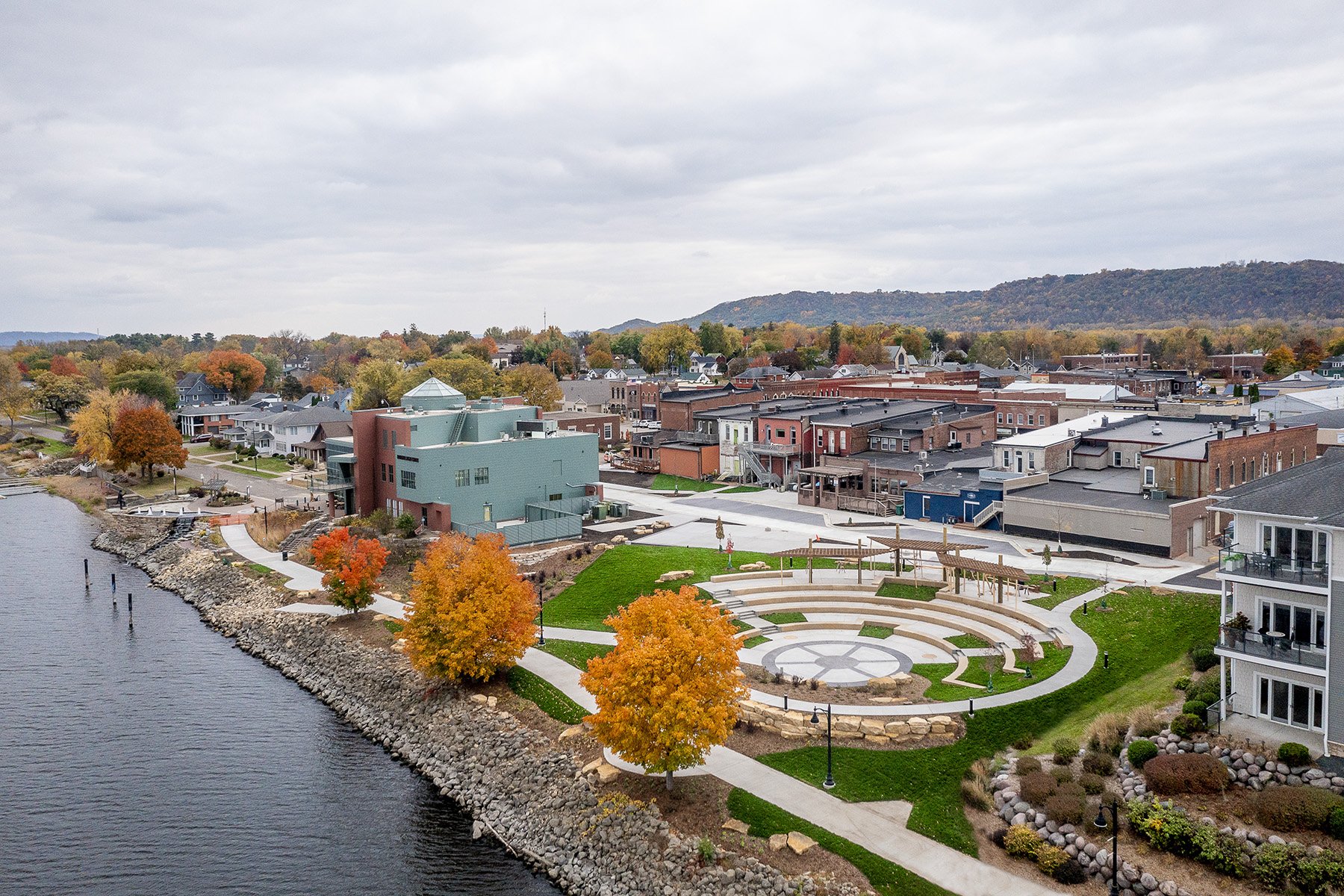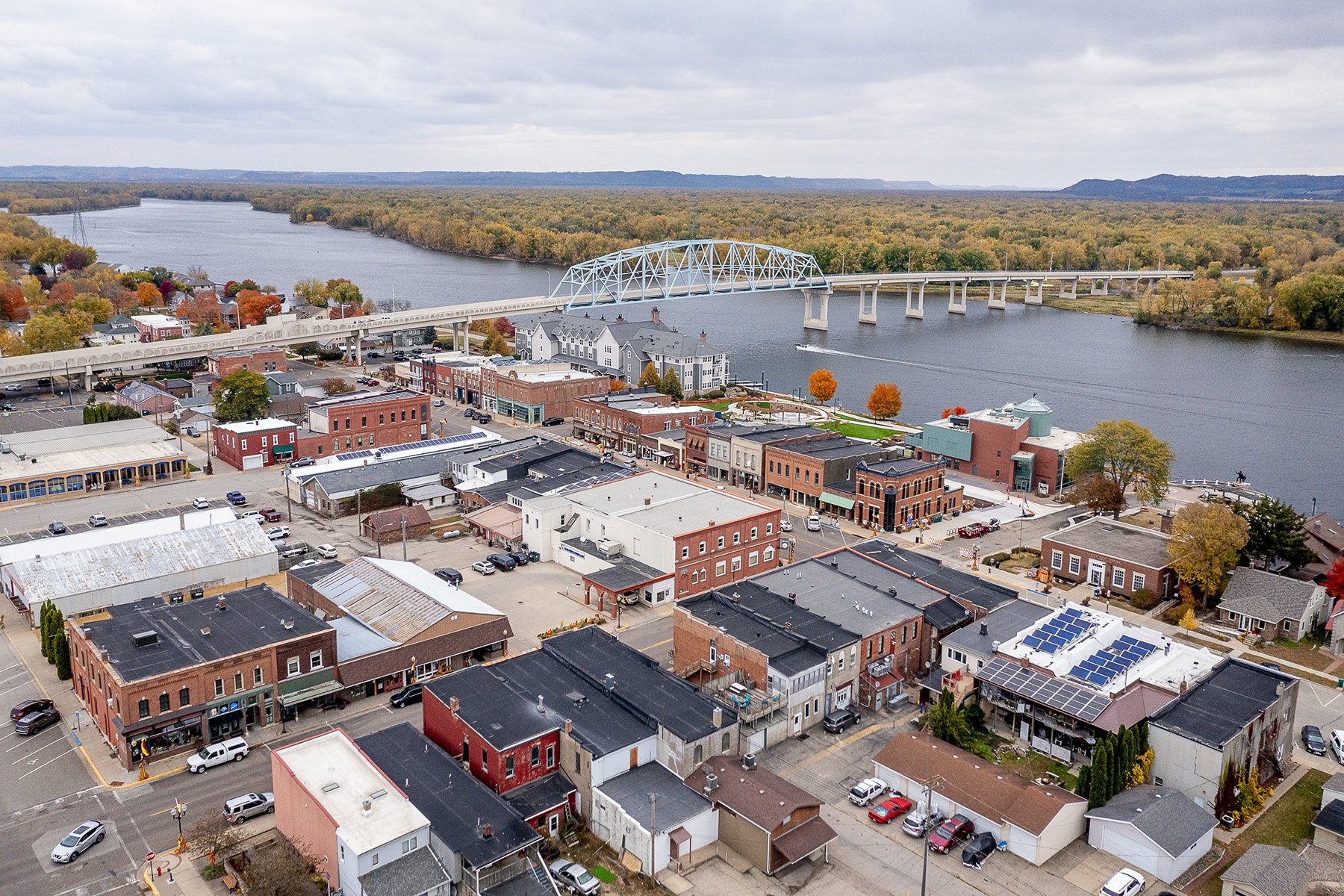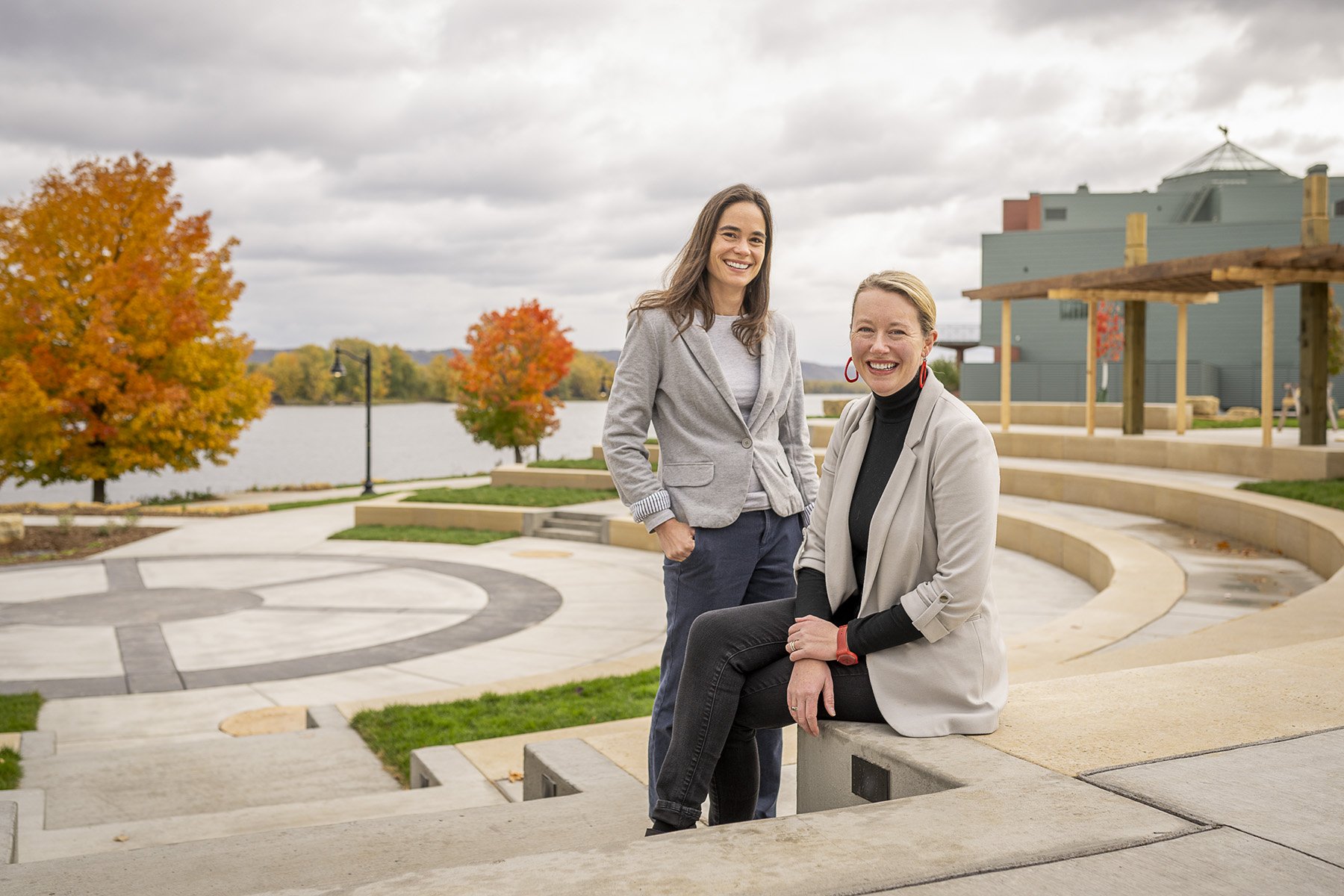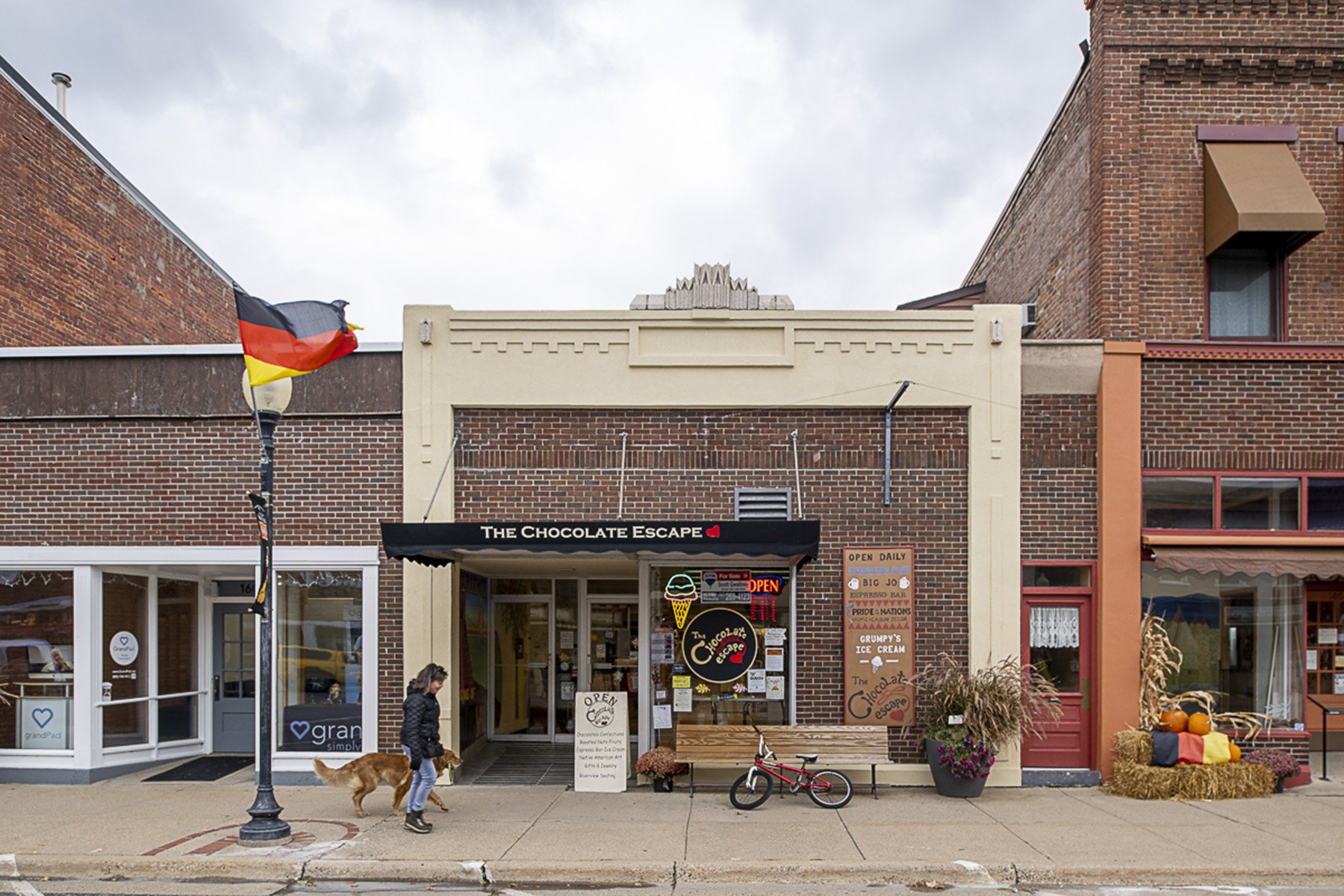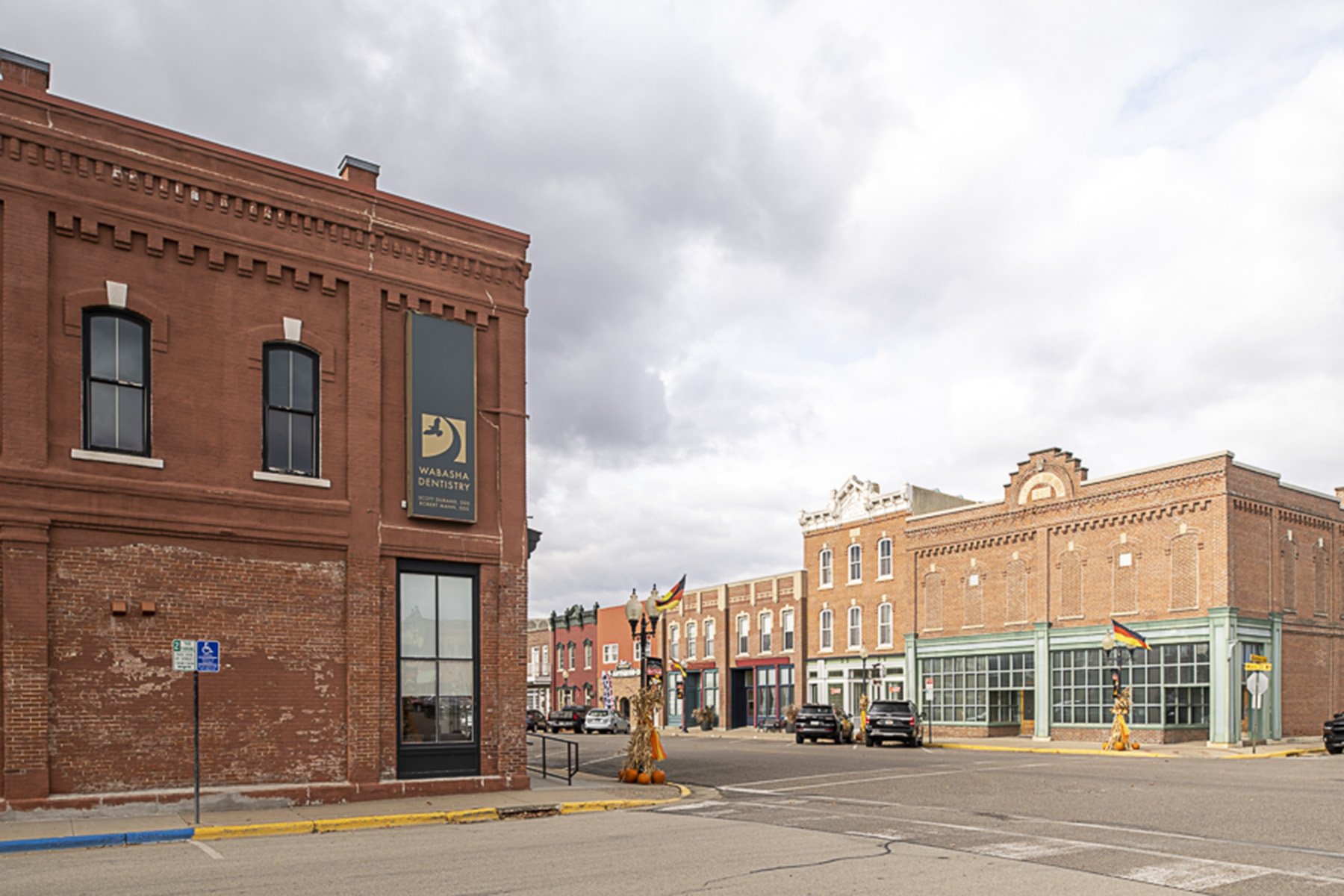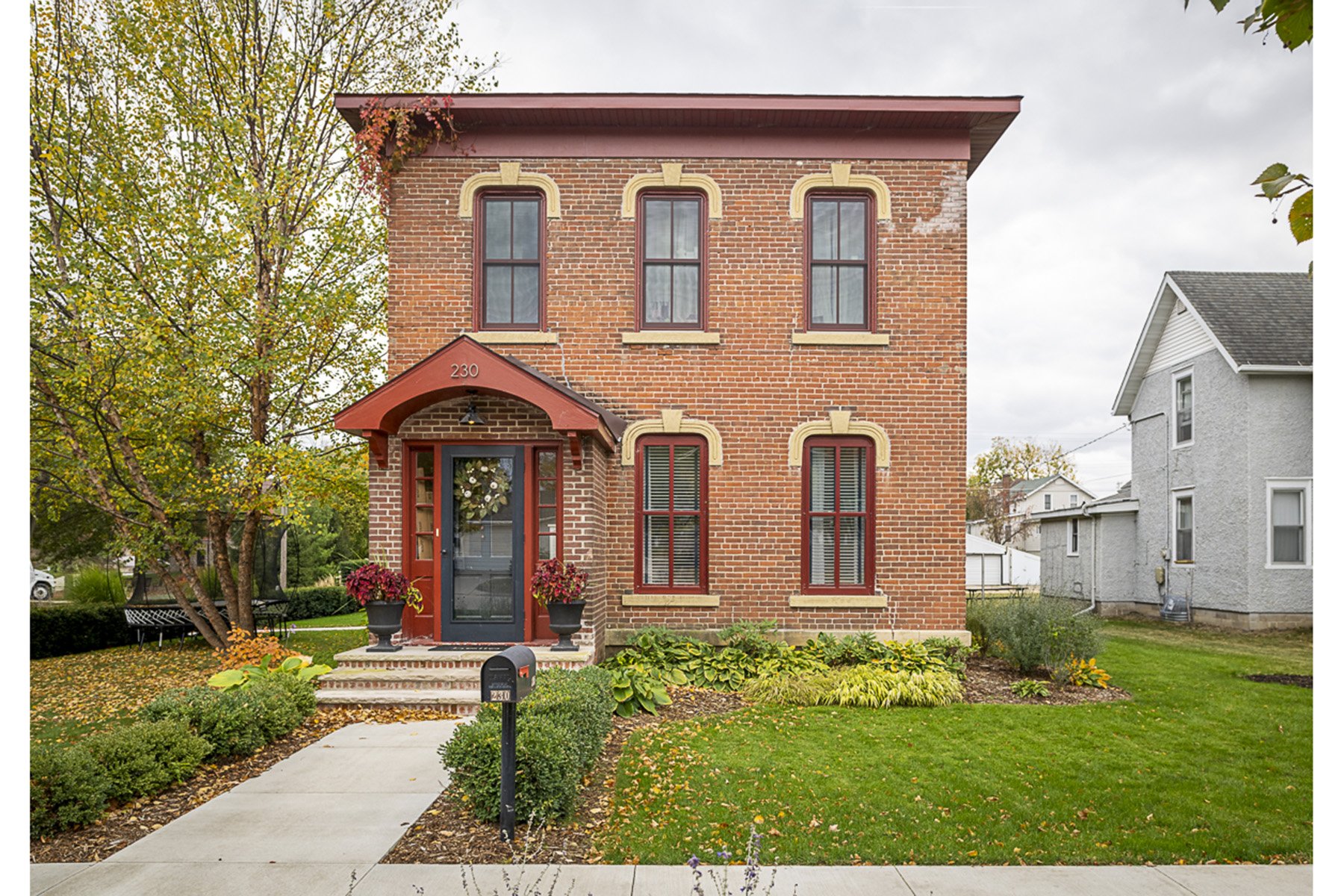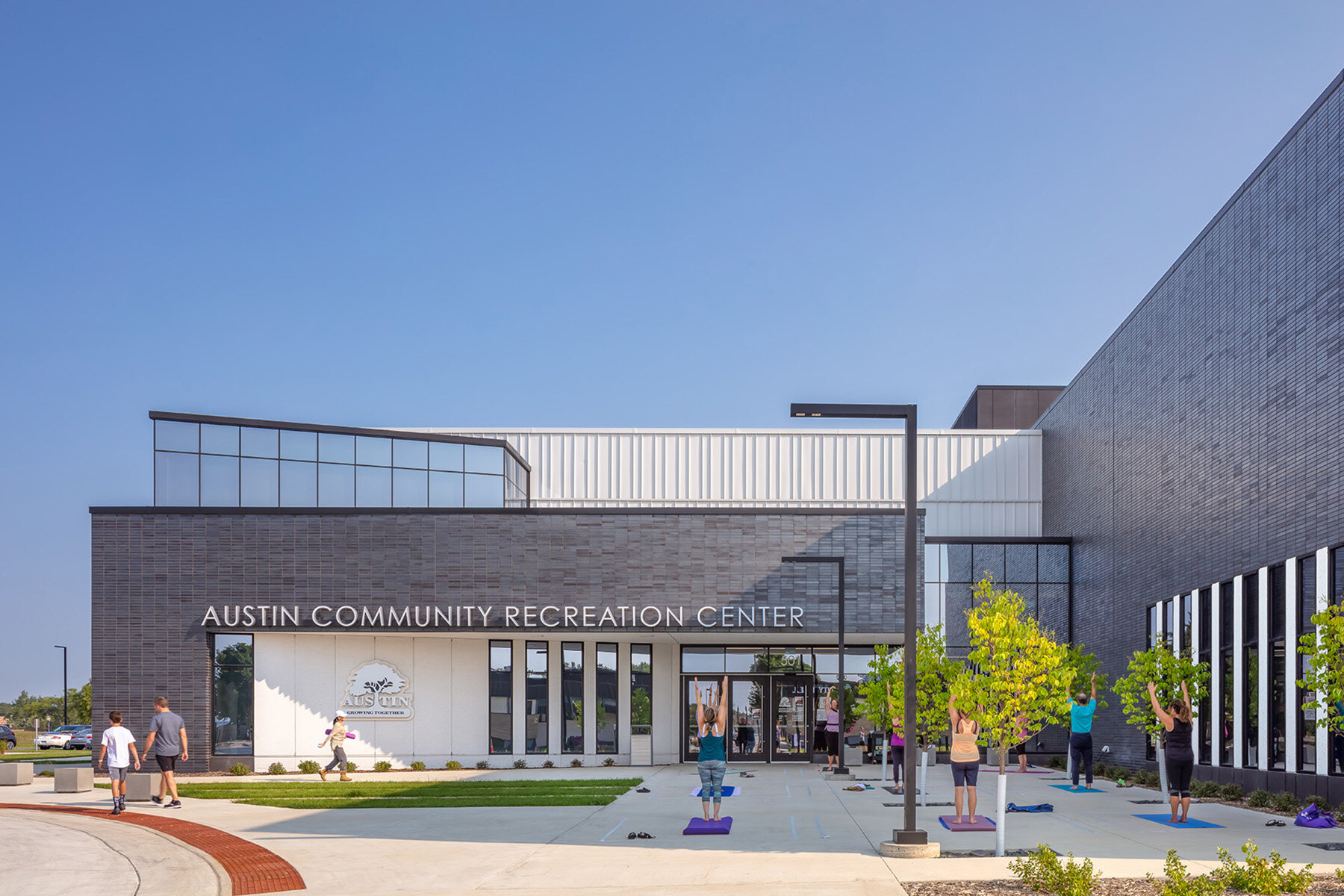Spotlight on Wabasha
The historic Minnesota river town continues to renew itself with the expansion of the National Eagle Center and a civic vision for additional development
By Sheri Hansen | May 1, 2023
Aerial view of the National Eagle Center and its new riverfront amphitheater in downtown Wabasha, along the Mississippi River. Photo by Chad Holder.
2023 PRINT ANNUAL
This feature appeared in the 2023 ENTER print annual, available for purchase here.
Nestled at the foot of Lake Pepin, where the Mississippi, Chippewa, and Zumbro rivers converge, Wabasha has been an active, adaptive river town since its early development in the 19th century. Today, city officials, community members, and design professionals are collaborating to sustain these community qualities for generations to come.
Interconnectedness
A stroll down Main Street and along the nearby riverwalk showcases Wabasha’s history and the natural wonders that make this area of Minnesota unique. New development in the form of a two-phase renewal and expansion of the National Eagle Center is bringing additional focus to these two leading community assets.
The riverfront looks out to an expanse of spectacular bluffs. Tourists with binoculars in hand come to catch a glimpse of America’s national symbol soaring in the wild—and not just in the warmer months. In winter, Wabasha becomes the best spot in the region to view bald eagles because fast-flowing currents keep its stretch of the river from freezing, providing the fishing eagles a ready-source of food. Tourists also come to experience a world-class museum that is home to four eagles and one red-tailed hawk.
The National Eagle Center had humble beginnings; it was established in an old restaurant storefront, housing documents and two injured bald eagles that could not be returned to the wild. As interest and resources grew, the community came together to plan a permanent waterfront museum in the 2000s. The outcome of that campaign—a 14,200-square-foot facility designed by architecture and engineering firm LHB—draws approximately 80,000 tourists and researchers to Wabasha every year to learn about the eagles and what makes the environment around the community so special.
National Eagle Center CEO Meg Gammage-Tucker takes pride in the center’s community origins. “When people from Wabasha saw eagles starting to come back to the area, they would share stories of the eagles that were here every winter with people who were traveling through,” she says. “It became a volunteer-driven activity based on ‘Let’s get together and share this conservation success story and the importance of this species to our world and environment.’ We have always been and will always be a community-driven organization.”
Images 1–3: Recent renovations to the National Eagle Center added eight new interactive exhibits and a new riverfront amphitheater, among other updates. A second phase of renovations will expand the center’s footprint on Main Street, in buildings directly across Big Jo Alley. All photos by Chad Holder.
The first phase of the center’s planned $27 million renovation and expansion by LHB, Inc., was completed last year. It included museum updates, eight new interactive exhibits, the partial renovation of two Main Street buildings into a new program and retail center, enhancements to Big Jo Alley, a riverfront amphitheater large enough for both museum and community programming, and public dockage. It also expanded and enhanced the eagles’ quarters to optimize their care. Placing the highest priority on the eagles is rooted not just in respect for the animals but also in the spiritual significance of eagles for the Native American people who have lived in the Wabasha region for thousands of years.
Just outside the museum entrance are a statue, a fountain, and three historical markers that highlight the history of the original residents of the land that is now called Wabasha. Three generations of Dakota leadership are recognized: Wapahasha I (1718–1806), who is considered the foremost hero in the national history of the Mdewakanton people; Wapahasha II, or La Feuille (1760s–1836), the namesake for the city of Wabasha (settlers at Rocque’s Landing changed the name of their town in his honor); and Wapahasha III, or Tatpsin (1812–1876), who, after opposing the Dakota War of 1862, was forcibly removed from Minnesota and worked to help his people rebuild their lives in Nebraska.
Gammage-Tucker is working with the leadership of the Prairie Island Indian Community to bring forward the Indigenous history of the area and the deep and abiding connection of many Native communities with eagles. Additional Main Street galleries will provide in-depth access to the internationally renowned Preston Cook American Eagle Collection, the world’s largest collection of art, artifacts, and memorabilia focused on eagles. “It comes back to interconnectedness, all around this one magnificent species,” says Gammage-Tucker. “Interconnecting humans and eagles historically, artistically, culturally, symbolically, and through conservation and nature.”
The two-phase project also advances the broader community goal of connecting the riverfront and Main Street in a way that benefits residents and visitors alike. “The center will have multiple front doors—not unlike a Smithsonian model,” says Bruce Cornwall, AIA, LHB’s director of design and campus planning, of the riverfront and Main Street facilities. “It’s one institution, but each area has its own strengths.”
“It comes back to interconnecting humans and eagles historically, artistically, culturally, symbolically, and through conservation and nature.”
The glue between the two areas is Big Jo Alley, a narrow two-block stretch of Lawrence Boulevard West with the museum and amphitheater on one side and the backside of Main Street buildings on the other. Named after Wabasha’s Big Jo Flour Mill, the enhanced thoroughfare gives the Main Street storefronts a riverfront presence.
“Big Jo Alley was designed both to host educational programs and with the idea that the community would be able to use it for everything from weddings and reunions to neighborhood concerts,” Cornwall explains. “It’s intended to be a celebration space that will generally have limited traffic, and no traffic at the time of big events. Between the dockage, the outdoor space, Big Jo Alley, and Main Street, the whole development is about the community.”
Adapting to Thrive
Throughout Wabasha’s history, community leaders have helped the city adapt to changing economies and the needs of its residents.
Once a center for trade, Wabasha grew through periods of heavy river traffic and lumber milling. As those industries began to slow, the city found ways to remain robust and relevant. Clamming was also once big business in Wabasha, with the shells used to manufacture buttons. Soon after synthetic materials were introduced, that industry wound down as well.
One constant in the cycles of change is Main Street’s Italianate architecture, dating back to the late 1860s. “The investment in Italianate buildings just blows your mind,” says Mayor Emily Durand. “The stories are what you would expect: Somebody came here and became a baker’s assistant, then took over the bakery, then expanded it. Then they turned it into a mercantile, then helped create a bank. We’ve never heard anything that would suggest there was community planning involved. There were simply builders who knew how to build these buildings and knew they could march down the street, building one after the next.”
Images 1–5: Wabasha Mayor Emily Durand (seated) and city administrator Caroline Gregerson in the amphitheater and meeting over coffee in the back of the Chocolate Escape, a popular Main Street shop with a back patio on Big Jo Alley. Wabasha is distinguished by its ornate 19th-century architecture along Main Street. Photos by Chad Holder.
Durand’s house is an example. “Our home is an early merchant house,” she says. “Lucas Kuehn built the house across the street for himself. He built our house for his eldest daughter, whose husband was his clerk, and then another next to ours for his next daughter. He also built a mercantile and a hotel. Just the amount of brick that this one individual is responsible for!”
Durand grew up in Western Minnesota, where booms and busts hit towns hard. During her years as a student at the University of Minnesota Morris, she worked with a local architectural historian who introduced her to ideas about community development. “He knew how to draft and how to envision,” she says. “He talked about architectural features that you’d want to reveal and why, and how to urge people to think about preservation from a pragmatic standpoint.” She has carried those lessons forward in her time on the Heritage Preservation Commission and now as mayor.
Durand’s husband went to architecture school, and the two share an enthusiasm for designing within constraints. The mayor navigates a variety of constraints and challenges in her leadership role in helping to shape Wabasha’s built environment.
For years, the city council has highlighted Wabasha’s housing shortage; addressing the issue is a priority in the city’s comprehensive plan. To tackle the shortage in a more structured way, the city recently contracted with CEDA (Community Economic Development Associates) and, on CEDA’s advice, joined Minnesota Housing Partnership’s Housing Institute, in a cohort with Janesville, Winnebago, and Winona. Supporting this work is a local group called WATCH (Wabasha Area Team for Community Housing), which includes realtors and brokers as well as representatives from the city, the port authority, and Gundersen St. Elizabeth’s Hospital. “Cities like ours don’t have coffers of money for things like planning,” says Durand. “And if we don’t find funds for planning, we don’t get funding to do anything else.
“We do have command of several parcels that are prime for [housing] development,” she continues. “The most meaningful one is what we call our athletic field at the terminus of the interstate bridge.” (Wabasha wants to relocate the highway alignment because travelers and trucks crossing from Nelson, Wisconsin, to Wabasha and Highway 61 need to make two hard turns through a residential neighborhood, then drive underneath a railroad overpass that is prone to flooding.)
“There was no economic boom that led to this development—just a lot of community investment and thoughtful, deliberate, difficult decisions.”
The vision that drives that development possibility—and the city’s development overall—is to reinforce Wabasha’s future as a flourishing river town. “It’s a great opportunity for all types of different housing possibilities as well as some commercial development,” says Durand. “The goal is to create this middle neighborhood that links our existing historic and newer neighborhoods.”
Durand has a deep appreciation for the expertise of those trained in the design disciplines, including that of the LHB team and others who have worked with Wabasha over the years. “Landscape architect Jason Aune gave us this beautiful concept: ‘Remember that, typically, what works for cities is what has worked for cities,’” she says. “Our old-fashioned street grid is very effective. Over the years, there’s been investment in some sidewalks. Not everywhere, but we have a sidewalk plan. We want that street grid to go through every neighborhood.”
Durand also embraces the process of experimenting, failing, and learning from those failures. “Not everything has to work,” she says. “You’ve got to fail sometimes to figure it out when there is no obvious solution.”
The mayor already considers the ongoing National Eagle Center expansion a great success. “Early on in the project, I thought, ‘I shouldn’t come down here every week, because I want to be wowed by the progress,’” she recalls. “But our business is right across the street, and my home is a block away, so I couldn’t really avoid it. It didn’t really matter, because once it was in full swing, something major was happening every week.
“You don’t often see public spaces of that caliber in a small community,” she adds. “We’re not a wealthy bedroom community linked to a metropolis. We’re a standalone rural community. There was no economic boom that led to this development—just a lot of community investment and thoughtful, deliberate, difficult decisions. What we’re accomplishing within the space and site constraints . . . well, the outcome is exceeding my imagination. And I have a pretty big imagination.”



